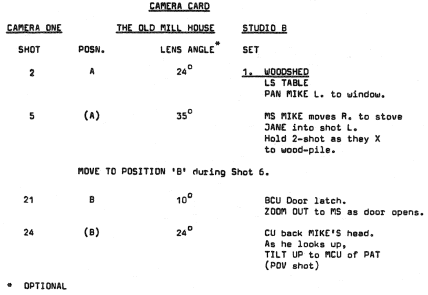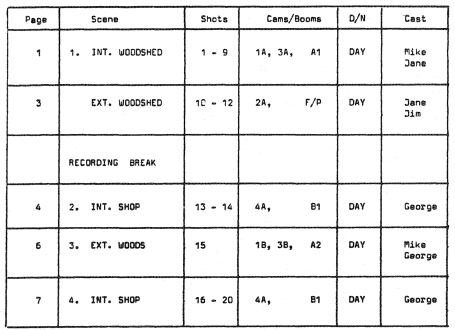Production Paperwork
Most creative workers hate paperwork. It is time-consuming to prepare. We doubt its accuracy after changes have been introduced. It can be confining and restricting to freedom of thought.
In reality, paperwork is an unavoidable link in providing dependable, complete facilities and operation and in ensuring coherent, unified teamwork. The larger the organization, the greater the need. Production paperwork takes so many forms (literally!) ranging from contracts, requisitions, permits, expenses, etc., to those directly guiding the studio team. Each specialist job has its specific associated documents, to arrange facilities, materials, labour, transport. Some may be used to feed computers, some just to remind Joe of a ‘phone call. But certain types of production paperwork are universal to all TV studio organization.
Scripts
The corrected draft script gives the story line/synopsis, dialogue, narration, basic scene-setting, action outline and stage directions. After working over, it becomes the rehearsal script. Here the page is split vertically. The existing script material is contained in the right-hand half, which is primarily concerned with audio information. As the director develops his picture treatment, this new camera information is typed in the blank left-hand section of the page. The combined script, now complete with all the production details the team needs to coordinate its shots, moves, cuing, timing, etc., has become the camera script. A semi-scripted show usually follows a much simpler format. Basic camera shots are indicated, with anticipated action, any agreed dialogue such as introductory or concluding speech, with indications of questions, graphics inserts, etc.
Running order/show format
This list segments the production, showing the program items, the set areas (scenes) involved, video and audio facilities needed (lighting conditions), major running time, and intended segment durations, together with performers’ names.
Camera cards/shot sheets/crib cards/shot list
The busy cameraman is too preoccupied to read a script. Instead, he has a series of cards clipped to his camera, giving him details for each of his shots. This includes the shot number, floor position (as marked on the camera plan), sometimes the lens angle, and a description of the shot (people involved, and their action) and camera movements, together with any additional instructions (e.g. ‘Hold 2-shot as they go to the door’). It may contain, too, a rough sketch of the studio layout, showing respective positions of the cameras (1 A, 1B, 1C, etc.).


